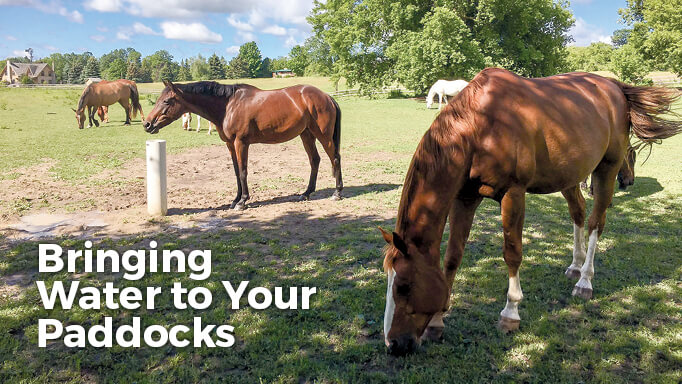Keeping horses properly hydrated in Canada can be a challenge: summers can get very hot and require larger quantities of water, while sub-arctic winter temperatures can mean frozen buckets and troughs. With these extremes, how can you provide fresh, clean water for your horse in every season?
The most effective way is to have an automatic water bowl which provides water on demand when horses are thirsty. There are three types of automatic waterers that require a water line running from the house or barn, or a separate pump house, on the market at the moment: frost-free, heated, and energy-free.
Frost-free systems have a water line that is below the frost line and runs up through the pipe to fill the bowl when the horse presses the valve. When the horse has finished drinking, unconsumed water flows back down into the ground so there is little chance of freezing.
Heated automatic bowls have a constant supply of water in them thanks to either a float, pressurized or balance system to maintain water levels as the horse drinks. They have a built-in heater to ensure that they do not ice over.
Energy-free systems have water available at all times, but require horses to be drinking consistently so that the bowl is being replenished with 10oC water all the time. This presents a problem in the winter when horses drink less and often come in at night – the bowl will freeze as the water is not constantly moving.
If you do not have a pressurized system there are other options available including natural water sources in the horse’s environment or stock tanks. Natural sources present various questions: will they freeze? Will they dry up in the summer heat? Could they be hazardous to the horses? (see below)
Stock tanks are a common option that people use; however, they come with their own set of issues. Refilling can be a challenge and unless your paddocks are very close to your barn, you’ll need a water cube and a vehicle capable of carrying it when it’s full to the paddocks. This is time-consuming for busy barn staff. Tanks need to be cleaned often in the summer as they accumulate dead leaves, hay, and algae. They also require a heater in the winter, which ends up being costly at $500-$800 a season to run if you are using a 1500-watt model.
Although what kind of water solution you choose depends on your farm’s individual variables and circumstances, automatic waterers are often the best choice as they require little maintenance and your horses will be thankful for the constant supply of clean, fresh, safe water available to them.

(Pam Mackenzie photo)
The Problem with Ponds
Natural water sources seem like a convenient and low-maintenance way to provide horses with water, but there are a number of possible hazards to consider:
- harmful chemicals from agricultural runoff which can cause blue-green algae, a source of dangerous cyanotoxins;
- disease transmission from wildlife who also drink at the pond, or insects who inhabit it (rabies, leptospirosis, EPM, Lyme disease, etc.);
- contamination from horse manure;
- injury from deep mud;
- drowning risk if the pond is deep, especially in the winter if it does freeze over.
The latter can be somewhat minimized by fencing off a specific small access area of the pond which can be waded out into just a short way and install a firm stone bottom. Pond aerators can help prevent the formation of algae and also prevent ice formation to some degree, but they can be pricey and require electricity.

